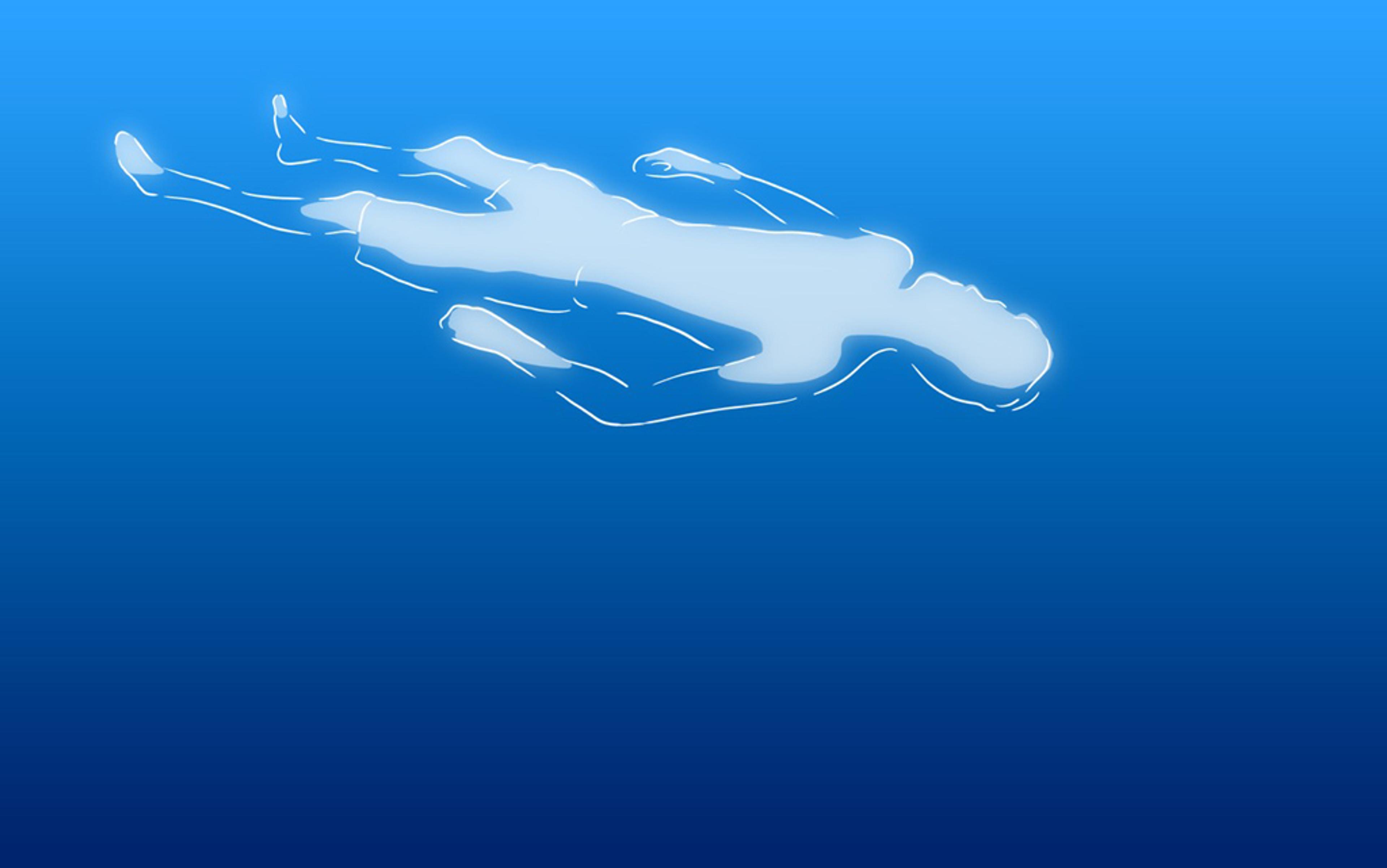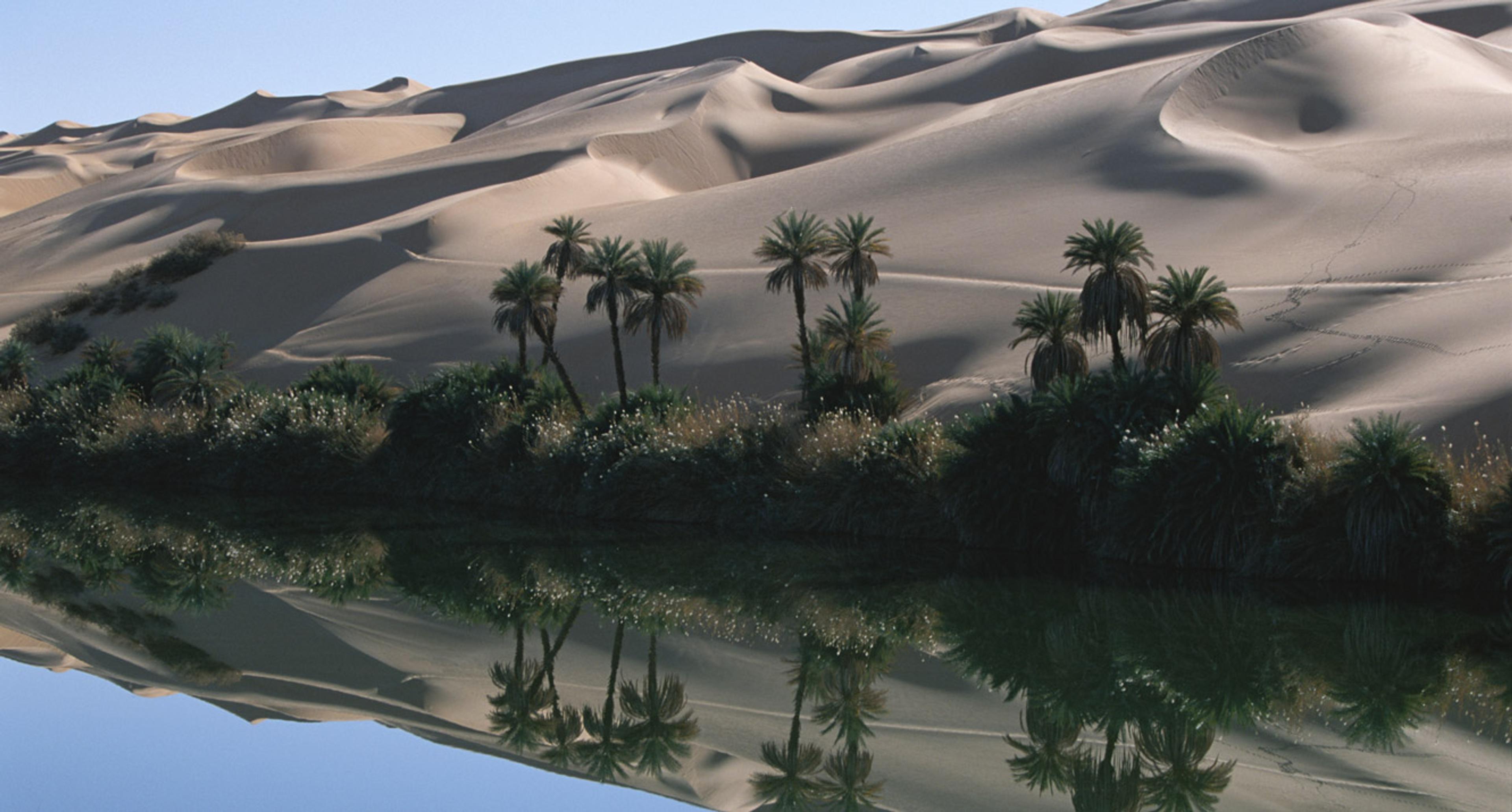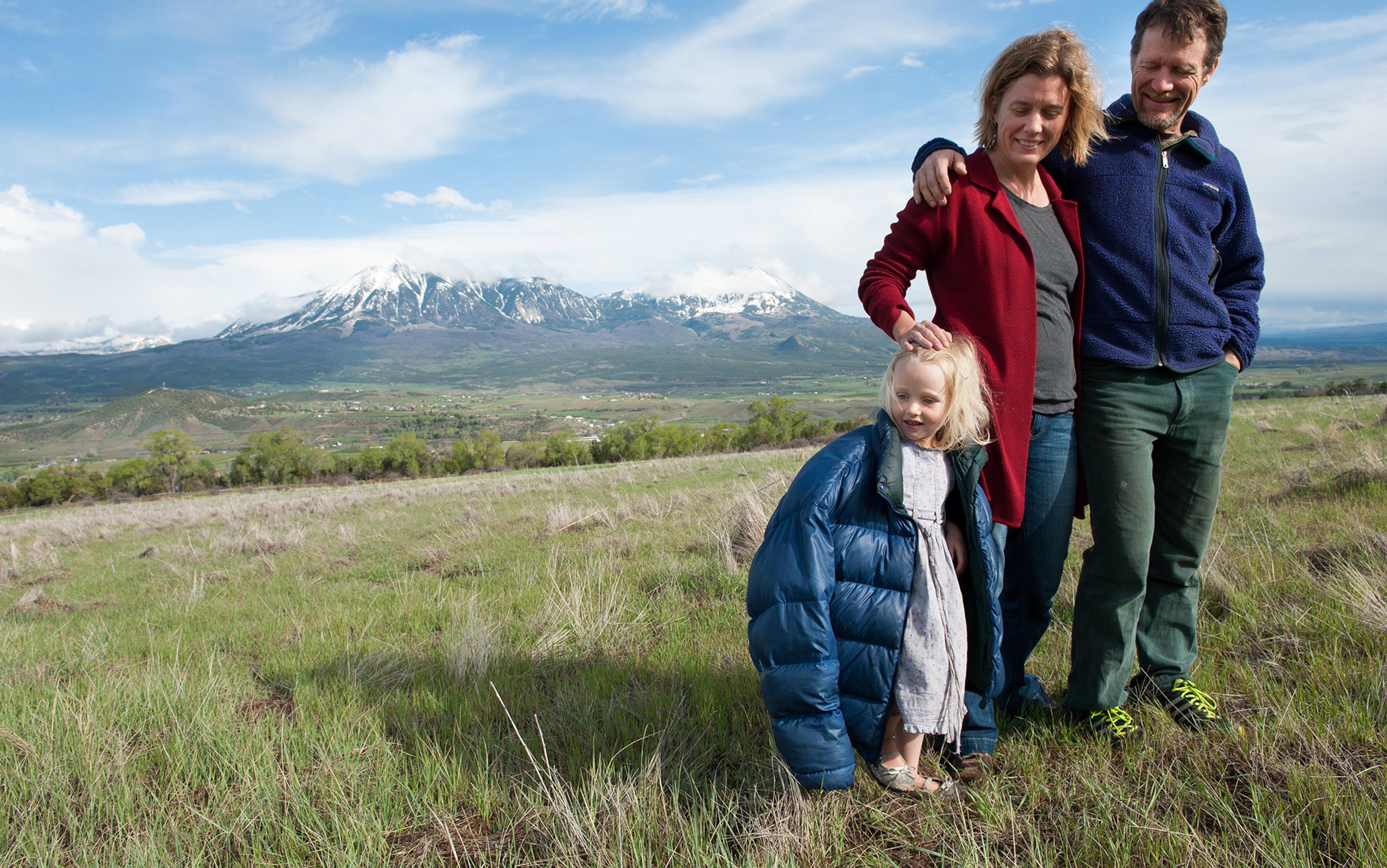The highway to Oroville, a small town in California’s Central Valley, runs into the foothills of the Sierra Nevada. As the road and the temperature climb, the neon lights of the valley’s box stores give way to orchards. Before the weather changed, this was a good place for fruit. Along the highway, hand-painted posters flash: ‘Fresh! Peaches’. The town was founded during the Gold Rush, and although today it’s home to more farmers than miners, it’s still a place where people search for what they don’t have. ‘Severe drought,’ highway signs blink. ‘Limit outdoor watering.’ There’s been no rain here since April, and the land is so dry even the moonlight is dusty. I’ve travelled 3,000 miles to California looking for a woman looking for water. I’ve come to a desert.
Sharron Hope, I’ve heard, can find water underground. As a dowser, she uses tools as simple as a stick to determine where to place a well. Holding a forked branch, Hope can tell if she is approaching a buried spring because she will feel these tools move in her hands. She can even estimate how many feet to dig and how many gallons per minute the finished hole will produce. She’s right so regularly that excavators often call her before breaking ground.
Of course, there are people who doubt Hope’s abilities. According to the United States Geological Survey: ‘The natural explanation of “successful” water dowsing is that in many areas water would be hard to miss.’ But the state is now entering its fourth year without enough rain, and this summer struggling farmers will let 620,000 acres lie fallow, losing an estimated $5.7 billion dollars. As increasingly desperate Californians turn to dubious and expensive long-term projects like piping water 1,400 miles from Alaska or building a billion‑dollar desalination plant in San Diego, dowsing for a well looks downright sensible. Hope’s become one of the few people sure of their answers, and the appeal of that certainty is easy to understand. The more difficult question is: how, in the middle of this century’s worst drought, is she still turning up water?
Hope agrees to explain over breakfast and suggests we meet at Oroville’s Gold Country Casino and Hotel. Just after sunrise, the parking lot is filled with dusty pickups. The farmers inside might have more of a chance at a jackpot than rain. The waterfall is closed for construction and the slot machines sing. Hope is waiting outside the café with a large map, a ruler and a pendulum – a long crystal on a silver chain. Dowsers use these tools to answer questions the same way one might use an Ouija board, by holding them and concentrating until they move one way for yes, and another for no, pointing their owner in the right direction.
We sit at a greasy vinyl booth. Hope pulls out a bird’s‑eye view of a client’s property and holds her pendulum over it. When the tool swings, she marks the spot with a black Sharpie. ‘Where it circles, that means there’s two water veins,’ Hope says. She’ll double-check her results in person. ‘You get on the land, and then you just concentrate.’ When the tools move, Hope knows she’s in the right spot.
Like dowsers, geologists look for water by preparing a map of the land. But their cartography focuses on the physical terrain, tracking where different kinds of rock come to the surface and plotting historical well data. Radar can reveal fractures in the ground where water might flow. Geologists combine this data for a pretty good guess at where underground aquifers might lie. ‘Geologists get a black‑and‑white printout that goes hundreds of feet down and shows you the layers of rock and openings where water might be,’ Hope says. ‘But they can’t actually tell you if there’s water.’ She took graduate hydrogeology courses at Chico State University 25 miles away, and she says that the more she learned, the more she thought: ‘I might as well go dowse. It saves people money and it’s just as accurate.’
However popular dowsing may be, the US Geological Survey takes pains to point out that it is not a science. Hope says: ‘If you call a geologist, it’ll cost you $2,000 a day.’ By comparison, she charges a one-time fee of $250 for a well-siting. Despite the differences in her methods, she works regularly with real estate agents and drillers, and the drought has multiplied her business. David Munch, an excavator who digs wells throughout the Central Valley, says he calls her anytime he has a client in the foothills. Her results speak for themselves: Hope has found dozens of wells this year.
The earliest record of dowsing is thought to be in the northern Sahara Desert at Tassili n’Ajjer, in what is today Algeria. A cave painting dated to approximately 6000 BCE shows a human figure holding a curved stick. A century later, the Greek historian Herodotus described a man using a golden dowsing twig. By the Middle Ages, dowsing was already popular and controversial. The German priest Martin Luther spoke out against divining rods after he began the Reformation in the 16th century, a time when his fellow countrymen dowsed extensively, according to the classic text on mining De Re Metallica (1556), written by the chemist Georgius Agricola. ‘Truly the twigs of the miners do move,’ Agricola writes.
All that was long ago, and the modern understanding of agriculture and irrigation – not to mention physics and chemistry – have turned finding water into a science. But somehow that hasn’t stopped Americans from dowsing, not just for water but for anything one could lose – keys, cats, ghosts, hope. ‘Coat-hanger dowsers,’ The New York Times Magazine reported in 1967, ‘are being used by Marine Corp engineers in the Vietnam War… to detect tunnels, mines, and booby traps.’
To this day, there are more than 2,000 active members in the American Society of Dowsers (ASD), who gather every summer in northern Vermont to share the tips and tricks of their trade. Their motto is ‘Indago Felix’, Latin for fruitful search. Hoping to gain some insight into why, in the age of hydrogeology, people hire dowsers, I decided to go.
The conference is held at Lyndon State College in Lyndonville, 40 miles from the Canadian border and near the ASD headquarters. It smells like sweet summer hay, and a woman with a long grey braid is walking through a labyrinth set up in the grass with stakes. Outside the gymnasium is a folding card table with brochures and laminated nametags. It’s awkward like the first day of middle school, except the hundreds of people here are predominantly over the age of 60. There are top hats, suspenders, and one woman in an electric-acid pant suit.
I’m signed up for Basic Dowsing School, where the technical (proper pounds per square inch of cable rigs, well-casing thicknesses) is mixed with the esoteric (‘Talk to your pendulum as if it were a person’). I hide behind my notepad as long as possible, jotting important instructions: ‘To clear a thought form, ask your higher self to vaporise evil.’
Like summer camp, a dowsing convention is one of those rare places where everyone is encouraged to participate; eventually one of the instructors sits down and hands me a pendulum. To my surprise, but not his, it swings in two different directions of its own accord. ‘There you go,’ he says. In the Dos and Don’ts section of the coursebook is a tip: ‘Don’t let your beliefs block examining new ideas – remember that a person’s judgment is no better than their information.’
‘How do people evaluate doubt? Science doesn’t have all the answers yet, which is something science won’t admit’
There’s no way to talk about something so outside normal experience without either becoming defensive or calling it crazy: belief and non-belief are universes that don’t touch, and residing between them is uncomfortable. That’s why Lee Ann Potter, the science officer for the ASD, has a difficult job. A former mechanical engineer, she tells me: ‘I’m trying to make dowsing more credible.’ She teaches a session on ‘Science and Dowsing’ at the conference, and the room gets crowded.
Potter learned about dowsing from a friend while working with the US Army, and she recognises that dowsing has a reputation problem. ‘One of the reasons it’s looked at as a pseudo-science is the inconsistency of empirical data,’ she says. But then she asks: ‘How do people evaluate doubt? Science doesn’t have all the answers yet, which is something science won’t admit.’
Potter might be right – science can’t tell you what to do when it doesn’t rain. But it’s soon clear that many people are not here looking for water. These dowsers specialise in everything from lost objects to earth energy to alien presences. At the evening Ecstatic Dance, our DJ is in a feathered hat and leopard-print pants. He instructs us: ‘No talking to allow for Spirit.’ Then we’re off, a woman with a mullet rolling on the floor and older white ladies in modest skirts conservatively bopping their knees. When the whooping and hollering starts, I’m swaying, me and this room of elderly strangers, dancing gracelessly and without shame. I don’t exactly feel Spirit. But I have to admit what’s been weighing on me – I’ve called on my higher self before.
In the mid-1990s, my recently-divorced young mother decided to learn how to access energy as a healing power. We travelled to the heart of the Cascade Mountains in Oregon, where a long dirt road curls around a river blued with glacial flour, and Douglas firs shade a collection of log cabins. This is where I met Kcaj. He started out as Jack, but when his garden was accidentally built off the wrong side of a blueprint, he changed his name; he had an ability to see another side of life. Kcaj helped me learn to see the world through a mystical lens. For a long while thereafter, I firmly and utterly believed I could tell the future.
This is not something I often tell people. In any rational sense, my ability was a lonely child’s memory of a difficult period. Making sense of life’s illogic reclaims a sense of power. So science stretches the bounds of human ingenuity in one direction, and faith in the other. It had been decades since Kcaj told me I had wise hands, but I walk away from the Ecstatic Dance still wondering: how do we decide what to believe in?
In the late 1800s, Sir William Barrett, at the Royal College of Science in Dublin, conducted some of the first scientific tests on dowsing; he had a hunch that it was a psychological rather than physical phenomenon, and suspected it would not be empirically provable. To investigate, Barrett asked a dowser to search not for water but for money. He put pieces of paper on dozens of chairs and hid a coin under one of them, then asked dowsers to find it. ‘The odds against finding the coin at the first venture were thus 45 to one,’ Barrett wrote, ‘but when Mr Young was called in, he immediately indicated the correct chair.’ When it was hidden once more, the dowser again successfully found it on the first try. At the end of five trials, Barrett concluded that Young’s successful dowsing defied odds of 80,000,000 to one.
Unfortunately, Barrett’s trials failed to control for biases. The chair selection wasn’t random, and it is unknown whether the chairs were moved between trials, making the tests possibly inaccurate and certainly unrepeatable, issues that have plagued dowsing.
Solco Tromp, a Dutch scientist, ran into the same issues when he tested dowsers’ sensitivity to magnetic fields in the 1950s. He reported that particularly sensitive people could detect less than 0.1 gauss of magnetism per metre. (For comparison, a toy magnet is about 1000 gauss.) But he didn’t report important details, such as trial length, or the number of subjects, or the number of trials, making the tests impossible to replicate.
In 2007, Chris French, a professor of psychology at Goldsmiths, University of London, finally conducted a rigorous, double-blind study of dowsing. ‘It’s theoretically conceivable there might be some kind of electromagnetic field people can pick up on to find water,’ French says. So he designed a test to explore what could be behind dowsers’ water-finding abilities. He told his subjects that he would put sand in some bottles and water in others. When the dowsers could see through the bottles, their tools gravitated toward the water, and they agreed the test was fair. Then French repeated the trial, but this time the bottles were in boxes and no one, including the testers, knew which held water. ‘Of course, it didn’t work,’ he says. The dowsers’ tools failed to find water statistically more often than chance.
French says the two tests got such different results because a person’s expectations can cause unintentional muscular movements, known as the ideomotor effect. The dowsers believed their tools were finding water, when in fact, their muscles were moving unconsciously. (The concept is similar to golf’s dreaded yips, where concentration leads to involuntary muscular tremors and loss of ability.) ‘Dowsers may be crediting a “divine” source for something they’re picking up on subconsciously,’ adds French, ‘and perhaps registering vegetation or rock types that they’ve previously associated with water.’
French points to a study published by Hélène Gauchou, a psychologist at the University of British Columbia, who found that using an Ouija board oddly increased subjects’ ability to answer questions. Gauchou thinks that the board helps people tap into memories they didn’t know they had. In other words, the act of using a divining rod might actually improve chances of finding water – just not for the reasons most dowsers think.
This kind of magical thinking is like catnip to skeptics. When Richard Dawkins investigated dowsing in 2007, he concluded that humans were no different than B F Skinner’s pigeons. In a classic psychology experiment in the 1940s, Skinner put hungry birds in a cage with a machine that provided food sporadically. He found that the pigeons soon associated whatever actions they happened to be making, like turning clockwise, with the food’s arrival. The birds would later perform the same actions in hopes of receiving more.
We’re wired to find the sources we agree with and to ignore the ones we don’t
Skinner speculated this was the basis of superstition, like wearing lucky socks. We act as if our behaviour has an outsized impact on the world because it’s discouraging to believe that things just happen: that good fortune is undeserved, that tragedy might have no meaning.
In our increasingly literate and technological society, this kind of superstition still has a surprising amount of power. James Alcock, a professor of psychology at York University in Toronto, says that’s because we’re fundamentally ‘belief-generating machine[s]’ with a ‘yearning unit’. We yearn to reduce fear, and develop our beliefs accordingly.‘Rationality and scientific truth have little to offer most people as remedies for existential anxiety.’
‘I think we’re all seekers,’ says Shirley Runco, another dowser in California. ‘Even if we don’t realise it. Everybody wants the truth and everybody wants to be happy. So they search.’
If you’re looking for meaning, believing in divinity might simply be more helpful than understanding entropy. But water, unlike God, is a tangible thing. So how can dowsers be so sure about something that can be proven false?
Some of their confidence could stem from a phenomenon known as confirmation bias, humans’ tendency to search for or interpret information in a way that proves one’s preconceptions. ‘A man with a conviction is a hard man to change,’ wrote the psychologist Leon Festinger in the 1940s. ‘Tell him you disagree and he turns away. Show him facts or figures and he questions your sources. Appeal to logic and he fails to see your point.’ Small wonder there’s a large gap between what the general population thinks about science-related topics and what scientists think. The Public and Scientists’ Views on Science and Society (2015), published by the Pew Research Center, shows an alarming disparity – as much as 40 per cent – in views on many important issues such as climate change and vaccines. We’re wired to find the sources we agree with and to ignore the ones we don’t. So when dowsers don’t find water, they’re inclined to blame the test conditions or the situation rather than their ability.
Where this gets tricky is that scientists aren’t immune to confirmation bias either. In theory, the scientific method asks questions – how does dowsing work? – and then attempts to test them empirically. Repeatable results are fundamental to truth. But in practice, perhaps because of confirmation bias, scientific results are not nearly as consistent as we’d like to believe: a report in Science this summer found that nearly two-thirds of the published experiments they considered could not be replicated. Brian Nosek, one of the researchers, explained to NPR: ‘Our best methodologies to try to figure out truth mostly reveal to us that figuring out truth is really hard.’
Back outside of Oroville, Hope and I rattle down a dirt road until we see a small man waving a well-used machete. Hope’s latest client, Khamsing, bought 15 acres with his life’s savings, and needs to drill a well so he can plant a small orchard of persimmon and peach trees. He gestures to where we should park her SUV. ‘The only things you have to watch out for,’ Hope warns me as we get out of the car, ‘are ticks and rattlesnakes.’ From the back seat, she pulls out a forked branch, just cut from a pine.
‘Sharron, you’re joking me,’ Khamsing says.
She just laughs. ‘It works really well,’ she says. ‘Trees have to find water.’
She wanders off across the dry grass and Khamsing turns to me. ‘Do you believe that? That the wood is moving?’
I shrug.
‘How?’ he asks.
Doubt can be a constant state of being. That’s why dowsers’ certainty is such a powerful force. ‘Hope convinces people to go deeper,’ says Munch, the excavator who has brought her here. Her conviction is important in the foothills, where crevice waters make his job difficult and clients scared by costs may tell him to quit before he hits water. ‘I can tell you for sure I don’t know where the water is, and it’s better than me throwing a can over my shoulder.’ Hope sites dry wells about 10 per cent of the time, in Munch’s experience, but he works with geologists as well. He says, ‘they’re not accurate either. And they’re a lot more expensive.’
‘Please don’t let Hope think that I don’t believe in what she does,’ Munch adds. ‘I have faith in the water that we’re going to find.’
That faith might not be misplaced. Hope has spent decades carefully studying Oroville’s landscapes in minute detail. She knows the names of plants and what kinds of soil different vegetation likes, providing insights into the local geography that the casual observer would miss. Dowsing, like any skill, takes practice, and Hope freely admits she’s better now than when she first began. It’s a different kind of knowledge than empirically-tested, scientifically-proven information, but it’s hard-earned knowledge nonetheless.
‘There’s a water vein under here,’ Hope says.
‘How deep?’ asks Khamsing, who came to the US from Laos 30 years ago. He needs a well, but it’s going to be more expensive to drill than he’d anticipated.
‘I can give you an estimate,’ Hope says.
‘Please. I don’t have much money left.’
When Munch drills here later, he’ll make a hole that produces two to four gallons a minute, just as Hope predicts.
Then Hope stoops over. ‘Look, quartz!’ she says, lifting a glittering rock. ‘Next you got to dowse for gold. You usually find gold where you’ve got quartz.’ Khamsing perks up. ‘Yeah, you never know!’ He smiles. ‘You never know!’






